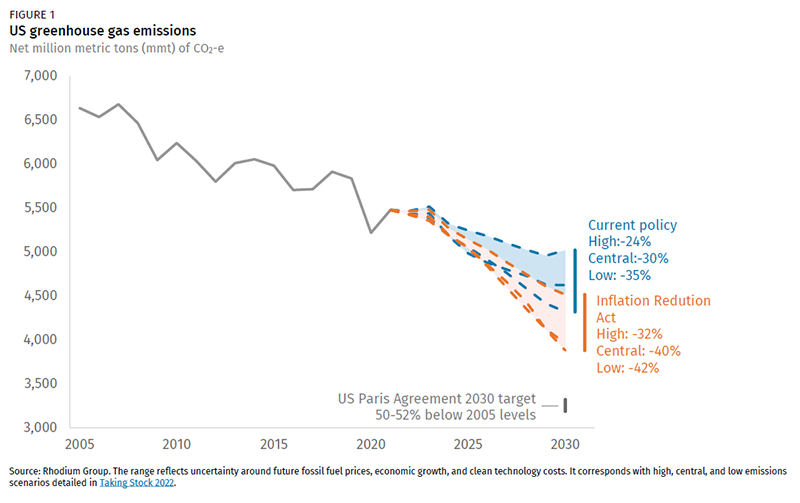Volcanoes are erupting in The Philippines, but on-fire Australia received some welcome rain. The Iran war cries have been called off and The Donald’s military powers are about to be hamstrung by the Senate. Meanwhile, his impeachment trial is starting, and we’re all on Twitter for a front-row seat.
What Could Go Right? Clean energy abundance
What the US stands to gain from the Inflation Reduction Act—the nation's largest-ever climate investment
This is our weekly newsletter, What Could Go Right? Sign up here to receive it in your inbox every Thursday at 6am ET. You can read past issues here.
The US passes major climate legislation
Last week, the United States passed the Inflation Reduction Act (IRA)—an expansive climate, tax, and health care bill that contains the largest federal climate investment in US history. On Tuesday, President Biden signed the bill into law.
Despite its name, the IRA is first and foremost a climate bill (more on that below). Second to that, it is a health care bill. It invests $64 billion to extend subsidies for health insurance through the Affordable Care Act, allows Medicare to negotiate the prices of up to 10 drugs starting in 2026, and caps out-of-pocket drug costs for Medicare recipients at $2,000 a year starting in 2025. According to The New York Times, it is “the most substantial change to health policy since the Affordable Care Act became law in 2010.”
Here’s what’s in the bill on climate:
Investments
Of the IRA’s more than $430 billion in total spending—paid for largely through a 15 percent minimum tax on large corporations, prescription drug price reforms, and increased IRS enforcement—$369 billion will go to climate and clean energy investments. These include subsidies and tax credits to drive both consumers and US manufacturers toward electric vehicles and cleaner energies and help lower energy costs.
Many of the bill’s manufacturing tax credits are aimed at spurring the domestic production of renewable technologies like solar panels, wind turbines, and batteries. Consumers, meanwhile, can get rebates for installing solar, buying electric vehicles, and making a host of energy-efficient upgrades to their homes.
On top of these and a slew of other clean energy incentives for companies and communities, the bill also includes $60 billion to help clean up pollution and reduce environmental injustice in disadvantaged communities.
There were some concessions made to appease Senator Joe Manchin and secure his vote. These include subsidies and credits for coal, oil, and gas. Manchin also insisted on a provision requiring the government to offer new oil and gas leases on federal lands and in the Gulf of Mexico. But as Grist points out, “it’s far from certain that oil and gas companies will want to build new drilling operations on that territory. The industry has shifted resources away from federal lands and the Gulf of Mexico in recent years, and there’s currently less capital available than ever for new production in these areas.” And if the IRA succeeds in reducing demand for fossil fuels by shifting the US to clean energy technologies, that’s going to continue to make fossil fuel developments less profitable.
For more on the bill’s spending and what’s in it for you, we recommend these breakdowns:
- The biggest climate bill of your life—but what does it DO!? | Vlogbrothers
- A guide to the US climate, health, and tax package | Financial Times
- Holy sh*t, the US just got serious about climate change! | How to Save a Planet
- A summary of the IRA’s tax breaks and rebates for individuals | CNBC
Emissions cuts
Even with the fossil fuel concessions, multiple analyses show that the IRA’s investments would move the US closer to reaching its target of reducing emissions by 50 percent below 2005 levels by 2030.
One report, from independent research firm Rhodium Group, estimates that the IRA’s climate investments could reduce greenhouse gas emissions by 32 to 42 percent below 2005 levels by 2030, compared to 24 to 35 percent without them. Analyses by two other groups—REPEAT Project, a Princeton-run energy and climate policy evaluator, and Energy Innovation, a nonpartisan energy and environmental policy group—were broadly similar in their estimates, putting emissions reductions with the IRA at around 40 percent below 2005 levels by the end of the decade.

Clean energy abundance
At its core, the IRA comprises what The Atlantic‘s Derek Thompson has called an “abundance agenda.” It is policy built largely on investments to make clean energy plentiful and affordable.
“Except for a tax on methane emissions,” writes economist Noah Smith, “the IRA employs subsidies rather than taxes. Instead of charging companies for emitting greenhouse gases, subsidies pay companies to switch to specific renewable technologies like solar power and electric vehicles.”
Smith adds that the subsidies in the IRA would not only reduce emissions in the US by making “‘cheap energy’ and ‘green energy’ synonymous,” but also incentivize other countries to decarbonize. If the IRA were to employ carbon taxes rather than subsidies, he says, this may in fact lead to decreased US demand for oil and coal, but that decrease on its own, absent the further development of inexpensive clean energy alternatives, would likely spur a drop in oil and coal prices on the international market and push other countries to buy up cheap fossil fuels.
“The incentives for the deployment of solar power, electric vehicles, hydrogen, heat pumps, electric home appliances, and other renewable technologies on a mass scale in the world’s largest (or second-largest) economy will continue driving the prices of these technologies down,” Smith writes, “and give all the countries of the world an incentive to adopt all of these things at an accelerated pace—which will in turn drive down prices even more. It’s a virtuous cycle—a key part of the Green Vortex that’s our best hope for beating climate change.”
The other big US climate bill
President Biden also signed into law the $280 billion CHIPS and Science Act last week. The bipartisan bill will provide $52 billion in subsidies to boost domestic semiconductor manufacturing and research. “What has attracted far less attention,” writes Robinson Meyer in The Atlantic, “is that the law also invests tens of billions of dollars in technologies and new research that matter in the fight against climate change.”
While agencies will still need to secure the right from Congress to direct the money toward specific uses, Meyer says the CHIPS Act could direct around $67 billion toward “accelerating the growth of zero-carbon industries and conducting climate-relevant research.”
Viewed together with the IRA and last year’s bipartisan infrastructure bill, Meyer writes, “these three laws are set to more than triple the federal government’s average annual spending on climate and clean energy this decade, compared with the 2010s.”
“Regardless of exactly how much new climate spending CHIPS ends up generating,” Meyer says, “the broader trend is clear. When you add CHIPS, the IRA, and the infrastructure law together, Washington appears to be unifying behind a new industrial policy, focused not only on semiconductors and defense technology but clean energy.”
Before we go
This bioengineered cornea implant has been used to restore sight to blind people. The low-cost implant, made from pig skin protein, could help bring sight to other visually impaired people in countries where human cornea transplants are in short supply.
A new Lyme disease vaccine is about to enter late-stage trials. If it proves successful, it would be the first federally approved human Lyme vaccine in the US in 20 years.
We heard that you can summon Tasmanian tigers by saying “thylacine” five times in front of a mirror. But these scientists are taking a different approach to resurrecting the extinct species and restoring its former ecosystems.
Below in the links section, the first wild jaguar cubs in decades in Argentina, free period products in Scotland, over-the-counter hearing aids in the US, and more.
Secretly Sexy
A pop-up section in which we celebrate numbers that represent substantial improvement in people’s lives
- 0 | The number of future coal shipments to Hawaii—the state’s last coal-fired power plant will shut down next month
- 36% | The amount of coral cover across two-thirds of the Great Barrier Reef—the highest level recorded in 26 years
- 17.8% | Cambodia’s poverty rate in 2020, down from nearly 40% in 2009
- 10 | The increase in years of healthy life expectancy in Africa between 2000 and 2019
- 114 | The number of countries with paid family leave for fathers in 2021, a 48% increase from 2011

Progress, Please
(Found good news? Tweet at us @progressntwrk or email.)
Other good stuff in the news
Environment:
- Researchers agree: The world can reach a 100% renewable energy system by or before 2050 | Helsinki Times
- Delhi airport becomes India’s first to run entirely on hydro and solar energy | Hindustan Times
- Chemists demonstrate ‘cheap and easy’ carbon-capture material | New Atlas
- A new green revolution is in the offing | Reason
- ‘Spiderwebs’ to the rescue for Indonesia’s coral reefs | Mongabay
- First wild jaguars in 70 years born in Argentina national park | Newsweek
- Saiga antelopes have increased tenfold after mass die-off in 2015 | New Scientist
- First sea turtle nest since 2018 found on Mississippi beach | AP
Science & Tech:
- How science is getting closer to a world without animal testing | Financial Times
- This 17-year-old designed a motor that could transform the EV industry | Smithsonian Magazine
- Nuclear fusion breakthrough confirmed: California team achieved ignition | Newsweek
- A deep learning model can almost perfectly predict how ice forms | MIT Technology Review
- Hydrogel that outperforms cartilage could be in human knees in 2023 | New Atlas
- Lightweight bionic zaps muscles to help you walk longer, faster | Freethink
Politics & Policy:
- Biden signs bill expanding health care benefits for veterans exposed to toxic burn pits | CNN
- Scotland becomes first country to provide free period products | Axios
- Colorado to stop sales tax on diapers and menstrual products | CBS News
- Massachusetts’ governor signs far-reaching climate bill into law | Grist
Covid & Public Health:
- FDA moves to make over-the-counter hearing aids available to millions | The Washington Post (h/t reader Nina)
- Covid vaccine designed to target two variants approved for use in UK | The Guardian
- A new gel could save the 50% of vaccines wasted annually | Freethink
- Experimental schizophrenia drug succeeds in advanced study | Boston Globe
- New ‘Parp inhibitors’ could prevent certain tumors appearing | The Guardian
- Scientific discovery may facilitate diagnosis of PTSD using saliva | Tel Aviv University
Society & Culture:
- This nonprofit is turning guns into garden tools | Good Good Good
- The US Army is making its first tactical bra | The Washington Post
- Pioneering art collection returns to Zimbabwe after 70 years | Africanews
Economy:
- Illinois is connecting farms to food banks to help battle hunger and inflation | Bloomberg
- This group has wiped out $6.7 billion in medical debt, and it’s just getting started | NPR
- US cancels $3.9 billion in student debt for 208,000 borrowers defrauded by ITT Tech | CNBC
TPN Member originals
(Who are our Members? Get to know them.)
- William MacAskill on effective altruism, moral progress, and cultural innovation | Tyler Cowen
- What’s long-term about ‘longtermism‘? | Matthew Yglesias
- The case for ‘shorttermism‘ | Robert Wright
- The Afghanistan withdrawal and the loss of US credibility | Faisal Saeed Al Mutar
- The case for high-skilled immigration reform (and how to make it happen) | Alec Stapp
- Steven Pinker and Scott Aaronson debate AI scaling | Steven Pinker
- In praise of readers | Gillian Tett
- Coleman Hughes on how America racializes its citizens | Yascha Mounk
- Mapping common ground: New reason to ‘think globally, and act locally’ | James Fallows
- To get out of your head, get out of your house | Arthur C. Brooks
- Why I believe in journalism | Alissa Quart
- The future of manned space exploration, with former NASA Deputy Administrator Lori Garver | James Pethokoukis
- What comes after the coming climate anarchy? | Parag Khanna
- Tilting our politics back toward democracy | Theodore R. Johnson
- On the future of American democracy | Jonathan Haidt
- Modern-day labor leaders on the movement for a living wage | Heather McGhee
- Europe’s energy crisis may get a lot worse | Jason Bordoff
- Ashton Applewhite on her ‘manifesto against ageism‘ | Ashton Applewhite
Department of Ideas
(A staff recommendation guaranteed to give your brain some food for thought.)
Learning by writing | Cold Takes
A process for organizing learning around writing.
Why we picked it: The piece is from a few months back. But I thought about its usefulness many times this week while trying to parse and write about the firehose of political noise in the news. It’s fun to see how often learning by writing crushes my inherent skepticism and makes me more optimistic. —Brian Leli
New Members Alert

Mustafa Akyol is a senior fellow at the Cato Institute’s Center for Global Liberty and Prosperity, where he focuses on the intersection of public policy, Islam, and modernity. He is the author of four books in English, most recently Reopening Muslim Minds: A Return to Reason, Freedom, and Tolerance.
Listen to Akyol talk about a liberal vision of Islam.

Ruth Ben-Ghiat is a historian who writes about authoritarianism, democracy protection, and propaganda. She publishes Lucid, a newsletter on threats to democracy. Her latest book, Strongmen: Mussolini to the Present, looks at how illiberal leaders use propaganda, corruption, violence, and machismo—and how they can be defeated.
Read Ben-Ghiat’s essay “Hope: the secret weapon of democracy protection.”
Until Next Time
Oops, we forgot to mention the Inflation Reduction Act’s provision to reinstate the 1990s!







